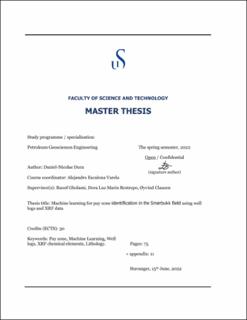| dc.description.abstract | As geosciences enter the age of big data, a faster and more sophisticated tool is needed to automate manual interpretation workflows, limiting industry professionals' ability to harness all available well-log data to reduce subsurface uncertainty and decision-making time. Moreover, new ways of improving the current state-of-the-art Machine Learning (ML) models' performance are needed.
Net Pay is critical in reservoir characterization, including estimating the original hydrocarbon in place, well test interpretations, calculations of ultimate recovery factors, and stimulation and completion designs (Egbele et al., 2005).
The motivation for the thesis is to create a more robust and consistent ML model for pay zone identification. For this purpose, the dataset for the study was constructed by performing conventional petrophysical analysis in the Smørbukk field, the Norwegian Sea, followed by identifying the pay zones and comparing the results with the available core data. In addition, XRF data was integrated with well logs to build four predictive classification models. This study demonstrates that ML can accurately identify pay zones with F1 scores ranging between 73 and 97%, and integrating XRF data can serve as an additional tool to improve reservoir characterization workflows.
The results indicate that XGBoost was the highest performing model regarding performance and validation time. The potential to integrate XRF chemical elements with well logs is promising as it can add up to a 4% improvement in identifying the pay zones. Finally, we compare all the models' performance and discuss possible reasons why vertical resolution and lateral and vertical variation in lithology impact the performance of the ML models as well as future approaches to have a more accurate assessment of the XRF data potential to enhance the overall classification performance and create a robust and consistent ML model for pay zone identification. | |
